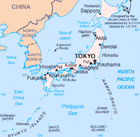Overview of Japanese Cuisine History
For Japanese people in "The Land of The Rising Sun," a meal is prepared with such artistry that the mere sight of it is delectable! Practically unknown to Western culture until the 1980's, food, and even the physical act of eating, differ significantly. The Japanese believe in keeping balance and harmony in nature. This is the reason most Japanese food are eaten raw. When it comes to raw Japanese food, the one thing that comes to mind is sushi. Nigiri-zushi is a type of sushi that has raw or cooked fish slices on rice. The other type of sushi, norimaki, has fish and vegetable pieces rolled with rice in nori (dried seaweed). Historically China and Korea have been the most influential, starting with the introduction of rice farming. Japan’s main source of nutrition and staple food for more than 2,000 years, rice used to be Japan’s currency from ancient times up until the mid-19th century. Back then rice was used to pay for taxes and wages, and how much rice one had was also a status symbol in Japanese society. Rice has made itself virtually irreplaceable in Japanese culture. In addition to being a staple food and a former currency, rice is the basic material or ingredient needed to make various products – from rice cakes and condiments, to ropes, paper, and sandals.
Cuisines of Japan
Japanese cuisine is world-renowned for it's highly skilled preparation methods and unique and refined presentation. Unlike many other types of Asian cuisines, Japanese do not rely on herbs and spice blends to season their dishes. Each ingredient is carefully selected and kept in harmony with it's own individual flavor. A traditional Japanese diet has high fiber content, and is low in calories and cholesterol. rice is the main starch and is present in almost every Japanese meal. udon and soba Noodles (hot or cold with many different types of accompaniments and dressings) is an important staple. Fish, Soya bean products, beans, seaweeds, vegetables, and fruit is an ever-present force in Japanese cuisine. Teriyaki, Tempura and Yakitori, (steamed, deep-fried, broiled and one-pot dishes), fill out a large of Japanese cuisine. Meals are generally taken three times a day and courses are not bothered with, as a simultaneous presentation is preferred. Tableware is carefully selected. Plates may be odd in shape and made of decorated lacquer or pottery. The size and shape of the dish must perfectly suit the food that is about to be served on it. Wooden chopsticks complete the plate. Another interesting thing about Japanese cuisine is how the environment just seems to melt into every dish. Even the outdoors is carefully represented. A Japanese chef may place a spray of pine needles or a leaf on your plate in accordance with the seasons. The key to understanding Japanese cuisine however is to realize the important role that seafood plays in a typical Japanese diet. Here Sushi and its cousin Sashimi come to mind. After all it is loved the world over and is the stamp for Japanese cuisine. Sushi can be defined as a dish, which contains sushi rice and cooked rice that is prepared with sushi vinegar, and it may contain cooked or uncooked fish. Sashimi consists of the fine cuts of fish and seafood (usually raw) except in cases of eel and sometimes Octopus which is prepared in combination with a lightly vinegered rice accompanied by daikon. Both are dipped in a Wasabi (green Japanese horseradish), Pickled ginger, and soy sauce combined or left separate. Sake (brewed rice wine) goes fantastically with a sushi meal and generally it is served warm. Finally no Japanese meal can be complete without a cup of green tea! Served before, during, or after a meal it is cleansing to the body, palate, and soul. At the heels of This culinary Japanese art form. So many of us have found a Healthy, eye-pleasing, and simple way of eating.

Map of Japan - Click to enlarge
Japanese Food Glossary
Finding the ingredients for a Japanese Recipe is not so easy when you do not know the names of the ingredients. Take time to make a list of ingredients and the name they may be found under at the Local Markets.
- Check out the Food glossary
Preparation Methods for Japanese Cooking
The best part about Japanese cooking is the meals are quick and easy to prepare. One thing to keep in mind whe preparing Japanese cuisine is "timing". Japanese cook thier food to the exact point of perfection. Here are a list of their cooking methods:
- Aemono - means "dressed and harmonized things" and refers to the way in which a salad is prepared.
- Suribachi and surkogi - Suribachi, a giant earthenwear "mortar" and surkogi, the corresponding "pestle".
- Agemon o- a term for "something deep fried".
- Mushimono - mushi means "to steam", Chicken, fish, and other seafoods and vegetables are steamed after being trated with sake and daikon.
- Nabemono - Nabe means "pot", and refers to the one-pot dish. Many of which are prepared at the table by the diners.
- Nimono - means "simmered dish" and is a method in which Octopus and other meat dishes are slow-cooked.
Special Equipment for Japanese Cooking
When sitting up a Japanese kitchen there are a few essentials that will not only make your meals a success but will also make it much easier to prepare them.
Japanese Food Traditions and Festivals
For the Japanese, holidays are a time of much eating and drinking! Discover the many holidays, festivals and seasonal celebrations of Japan.
People in Japanese Food
- Are you into Japanese Cooking and would like to be interviewed?